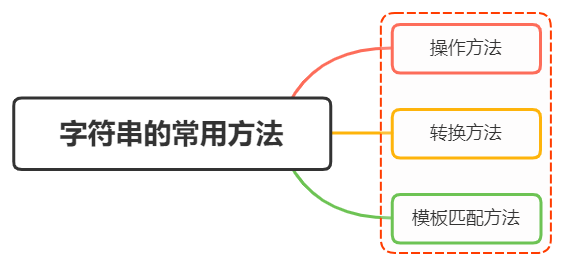# 每日一问:JavaScript字符串的常用方法有哪些?

# 一、操作方法
我们也可将字符串常用的操作方法归纳为增、删、改、查,需要知道字符串的特点是一旦创建了,就不可变
# 增
这里增的意思并不是说直接增添内容,而是创建字符串的一个副本,再进行操作
除了常用+以及${}进行字符串拼接之外,还可通过concat
# concat
用于将一个或多个字符串拼接成一个新字符串
let stringValue = "hello ";
let result = stringValue.concat("world");
console.log(result); // "hello world"
console.log(stringValue); // "hello"
# 删
这里的删的意思并不是说删除原字符串的内容,而是创建字符串的一个副本,再进行操作
常见的有:
- slice()
- substr()
- substring()
这三个方法都返回调用它们的字符串的一个子字符串,而且都接收一或两个参数。
let stringValue = "hello world";
console.log(stringValue.slice(3)); // "lo world"
console.log(stringValue.substring(3)); // "lo world"
console.log(stringValue.substr(3)); // "lo world"
console.log(stringValue.slice(3, 7)); // "lo w"
console.log(stringValue.substring(3,7)); // "lo w"
console.log(stringValue.substr(3, 7)); // "lo worl"
# 改
这里改的意思也不是改变原字符串,而是创建字符串的一个副本,再进行操作
常见的有:
trim()、trimLeft()、trimRight()
repeat()
padStart()、padEnd()
toLowerCase()、 toUpperCase()
# trim()、trimLeft()、trimRight()
删除前、后或前后所有空格符,再返回新的字符串
let stringValue = " hello world ";
let trimmedStringValue = stringValue.trim();
console.log(stringValue); // " hello world "
console.log(trimmedStringValue); // "hello world"
# repeat()
接收一个整数参数,表示要将字符串复制多少次,然后返回拼接所有副本后的结果
let stringValue = "na ";
let copyResult = stringValue.repeat(2) // na na
# padEnd()
复制字符串,如果小于指定长度,则在相应一边填充字符,直至满足长度条件
let stringValue = "foo";
console.log(stringValue.padStart(6)); // " foo"
console.log(stringValue.padStart(9, ".")); // "......foo"
# toLowerCase()、 toUpperCase()
大小写转化
let stringValue = "hello world";
console.log(stringValue.toUpperCase()); // "HELLO WORLD"
console.log(stringValue.toLowerCase()); // "hello world"
# 查
除了通过索引的方式获取字符串的值,还可通过:
chatAt()
indexOf()
startWith()
includes()
# charAt()
返回给定索引位置的字符,由传给方法的整数参数指定
let message = "abcde";
console.log(message.charAt(2)); // "c"
# indexOf()
从字符串开头去搜索传入的字符串,并返回位置(如果没找到,则返回 -1 )
let stringValue = "hello world";
console.log(stringValue.indexOf("o")); // 4
# startWith()、includes()
从字符串中搜索传入的字符串,并返回一个表示是否包含的布尔值
let message = "foobarbaz";
console.log(message.startsWith("foo")); // true
console.log(message.startsWith("bar")); // false
console.log(message.includes("bar")); // true
console.log(message.includes("qux")); // false
# 二、转换方法
# split
把字符串按照指定的分割符,拆分成数组中的每一项
let str = "12+23+34"
let arr = str.split("+") // [12,23,34]
# 三、模板匹配方法
针对正则表达式,字符串设计了几个方法:
- match()
- search()
- replace()
# match()
接收一个参数,可以是一个正则表达式字符串,也可以是一个RegExp对象,返回数组
let text = "cat, bat, sat, fat";
let pattern = /.at/;
let matches = text.match(pattern);
console.log(matches[0]); // "cat"
# search()
接收一个参数,可以是一个正则表达式字符串,也可以是一个RegExp对象,找到则返回匹配索引,否则返回 -1
let text = "cat, bat, sat, fat";
let pos = text.search(/at/);
console.log(pos); // 1
# replace()
接收两个参数,第一个参数为匹配的内容,第二个参数为替换的元素(可用函数)
let text = "cat, bat, sat, fat";
let result = text.replace("at", "ond");
console.log(result); // "cond, bat, sat, fat"
